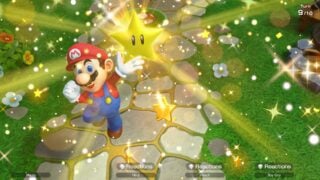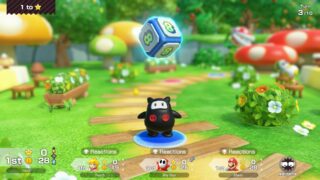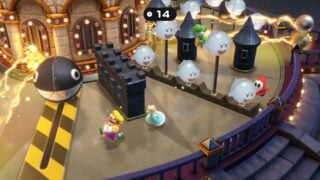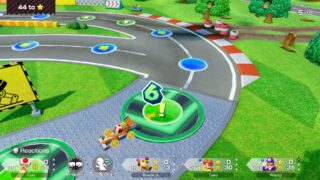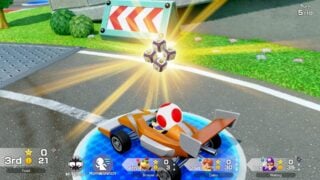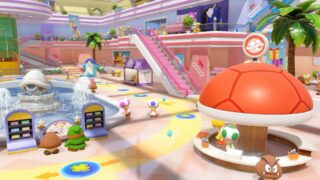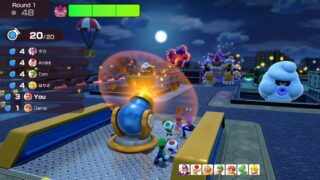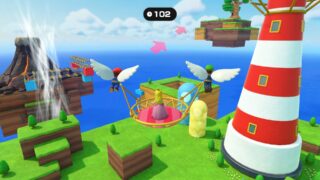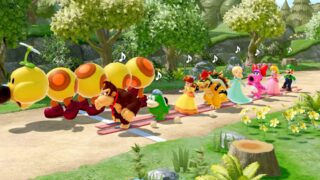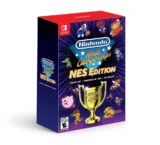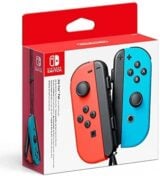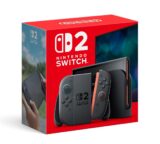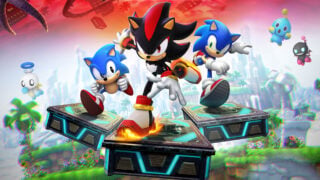Super Mario Party Jamboree is one of the best in the series
Nintendo’s 18th entry excels in both volume and diversity of content
- Director
- Takeru Sugimoto
- Key Credits
- Arata Kobayashi (Art director), Ichiro Shimakura (Sound director)
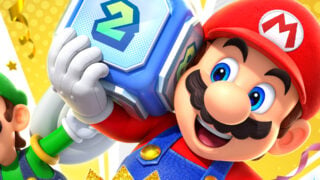
It’s easy to have lost track over the years, but this is actually the 18th game in the Mario Party series.
Ever since the original was released on the Nintendo 64 a quarter of a century ago, Nintendo has frequently put out updated takes on its popular party game formula, and over the past 12 years these have been handled by the recently-renamed studio Nintendo Cube (formerly Nd Cube).
Given the regularity of the instalments and the familiarity of the developer, then, it stands to reason that this latest offering would be expected to be running short on surprises. In reality, while there’s certainly some familiarity to be found in Super Mario Party Jamboree’s main modes, there are a pleasing number of new features here.
Naturally, the flagship Mario Party mode remains the main draw. There are four boards to initially choose from, with a further three unlockable ones (including a couple of retro boards from the first two N64 titles).
As ever, each board includes numerous bespoke events that trigger as you pass by them, from a wandering Wiggler who carries part of the board on his back, to a Toad pit crew on the Mario Kart board who’ll offer to ‘fill your tank’, which essentially means filling all three of your power-up slots.
The main new feature in the main mode this time is the introduction of Jamboree Buddies. The idea of temporarily partnering up with another character isn’t a new one and has been in a couple of Mario Party titles before, but this is a new take on it which can lead to some interesting turnarounds.
At random points the Jamboree Buddy will appear on the board for a limited time. If anyone reaches them before they disappear, it triggers a lengthy four-player mini-game where the winner earns their services (even though anyone can win, the player who reached the Buddy will get an advantage).
If you win the game and claim the Jamboree Buddy then, for three turns, they’ll give you a bunch of benefits. They’ll boost your dice so they always roll high, they’ll double the effects of any space you land on (so a space giving 6 coins will now give 12) and if you reach a Star while they’re with you, you’ll get the option to spend double and buy two of them at once.
There are still risks involved too – negative spaces (including the punishing Bowser ones) have a double impact too, and if an opponent overtakes you they’ll steal the Buddy and get use of them instead.
Outside of the Mario Party mode, the other big offering Nintendo has been trumpeting this time is the Koopathlon. This is another mode that takes an idea from a previous game – in this case the Coinathlon from 3DS title Mario Party: Star Rush – and heavily repurposes it into something different.
Whereas that was a four-player mini-game competition, here you have a 20-player mode (which can be played online or locally with bots making up the numbers). The aim is to complete a set number of laps around a lengthy track by collecting coins in a series of mini-games.
“The idea of temporarily partnering up with another character isn’t a new one, but this is a new take on it which can lead to some interesting turnarounds.”
As the mini-games play out on the left of the screen, you can see your character’s progress on the right. The games are single-player offerings designed to dish out loads of coins to skilful players, so the satisfaction in performing one very well and watching your character pull out in front of the pack is strong.
Koopathlon isn’t quite the lengthy Fall Guys-style battle royale version of Mario Party you may have been hoping for, but it’s a fun diversion from the main mode and a great way of playing Mario Party online without having to dedicate a lot of time to playing through a standard board.
The same goes for Bowser Kaboom Squad, which is an eight-player co-op mode. Here a giant Bowser is stomping his way through a small open world and you have to defeat him over five rounds by breaking crates, collecting the bombs in them and loading a cannon.

Each round ends with a mini-game which gives you a choice of progressively power-ups depending on how well you do, from the ability to drop bananas to make enemies fall, to the ability to break crates quicker, pick up more bombs or place speed boosts on the floor to get around quicker.
Again, it’s an amusing alternative to the main game and can be a laugh when played with friends, especially if you play on a higher difficulty level where you have to commit to playing strategically if you want to do enough damage to Bowser within the five rounds.
These are joined by a bunch of other modes, from the motion-controlled Paratroopa Flight School (which involves a few mini-games based on flying by flapping Joy-Con controllers like wings), to the ace co-op puzzle game Toad’s Item Factory. Each of these is enjoyable in its own way, there are very few stinkers here.
“Koopathlon is another mode that takes an idea from a previous game – in this case the Coinathlon from 3DS title Mario Party: Star Rush – and heavily repurposes it into something different.”
While all these modes are designed for multiple players (though the vast majority can be played solo with bots), Party-Planner Trek is the main single-player mode and brings together the mini-games in a rather basic adventure.
In Party-Planner Trek, players get to freely explore the boards from the main game, and can move between the spaces in any direction they want. As you move along, you’ll see items lying around and NPCs who are inevitably looking for them. By performing a bunch of basic fetch quests like this you’ll collect Mini Stars, and once you get enough you’ll take on a boss battle before moving to the next map.
It’s hardly going to give Breath of the Wild any sleepless nights (should’ve bought an Alarmo) but younger players will have a fun time helping out the Mushroom Kingdom residents at their own pace. It’s harmless enough.

No Mario Party game is flawless and there are issues here too, though there are certainly fewer than usual. Some of these are unique to Jamboree – the new Buddy gimmick in the main mode is a fun idea but there are moments when it gets in the way.
The best example of this is one game we played where the Buddy was collected in the last turn, by the player who was third in the roll order. As previously explained, when a Buddy is reached it triggers a mini-game to see who gets them, and some of these can be very long (the Luigi one in particular, who was the one we got in this instance).
As such, we had to play through a lengthy but ultimately meaningless mini-game that took up a few minutes and was ultimately irrelevant to the outcome of the game. We’d have appreciated the option to skip the Buddy if they’re collected so close to the end, but understand that there will also be rare situations where he can actually lead to a last-minute change.
“There’s also that ever-present gripe we have that despite being a party game that’s clearly aimed at entire families, those who are good at video games will still have the edge.”
Other issues are general ones that aren’t new for fans of the series. Although there are over 100 mini-games we never really felt drawn to many of them and didn’t really end up with any favourites we were hoping for, something that wasn’t the case in the N64 and GameCube days.
There’s also that ever-present gripe we have that despite being a party game that’s clearly aimed at entire families, those who are good at video games will still have the edge.
The game still does what it can to even the odds with some of its more luck-based mini-games and the way it dishes out Stars for random things at the end, but ultimately more skillful players get more coins in the mini-games and therefore have a better chance at winning.

A new Pro Rules option is clearly aimed at these very players – designed to remove some of the random element and make it feel more like a proper skill-based competition (the dice-rolling aside, of course), Pro Rules will likely become the option of choice when a group of equally competent players take part.
Little siblings and less enthused parents, however, will still find themselves near the back of the pack if teenage Johnny Gamer Chair is part of the family play session, so even more handicap options would perhaps be a nice move in the future.
In general, though, Jamboree is certainly one of the better games in the Mario Party series, certainly when it comes to the sheer volume and diversity of content it boasts.
Depending on how long Nintendo continues to support the Switch after its successor is released, this could potentially be the last game in the series to release on the system.
If this ends up being the case, it’s a fitting third and final Mario Party on Switch – following the Joy-Con heavy gameplay of Super Mario Party and the old-school focus of Mario Party Superstars, this hits that Goldilocks spot by delivering the best aspects from both.
Jamboree is one of the best Mario Party games to date, due to the sheer number of modes available and their general high quality. It still hasn't managed to shake some of the core issues of the series (especially when it comes to balancing the game for younger and less experienced players) but judged against previous entries it stands out as a top offering.
- Seven entertaining boards with a fun Jamboree Buddy gimmick
- 20-player Koopathlon is good for shorter online matches
- Has a wider selection of modes than most Mario Party games
- You can choose to avoid the motion-sensing games if you want
- Still hasn't quite nailed the balance when experts and beginners play
